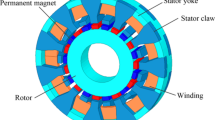Abstract
Overloading a high-speed permanent magnet synchronous machine (HSPMSM) results in a crucial increase in power losses, thus causing temperature rises in the HSPMSM, which can affect its electromagnetic and thermal performance. It is crucial to focus on critical temperature rises in HSPMSM’s components to avoid fault or excessive machine lifetime degradation caused by thermal stresses. Hence, both electromagnetic and thermal behavior need to be estimated accurately to ensure a safe machine’s operation. In the traditional thermal study by lumped parameter thermal network model (LPTNM), the losses induced in HSPMSM by electromagnetic prediction are comparable to the heat sources, and only the consequent thermal behavior is examined. Thus, thermal analysis of HSPMSM by single-way coupling of electromagnetic losses to LPTNM is less accurate. The two-way coupling approach of electromagnetic–LPTNM for HSPMSM is developed and implemented in this article, in which both the distributions of temperature and the temperature rise are estimated at steady and transient overload conditions, respectively. Due to the consideration of the two-way coupling effect, the electromagnetic and thermal characteristics could well be estimated more precisely using a limited number of iterations between the electromagnetic and LPTNM. The experimental testing of the two-way coupled predicted model results reveals that the suggested approach possesses superiority in both estimating performance and precision over traditional LPTNM, and it can be extended to different electrical machines.















Similar content being viewed by others
References
Abubakar U, Wang X, Shah SH, Wang L, Farouk A (2022) Electromagnetic and thermal analysis of 225 kW high-speed PMSM for centrifugal blower applications. Energies 15(9):3370
Bertotti G (1988) General properties of power losses in soft ferromagnetic materials. IEEE Trans Magn 24(1):621–630
Chen L, Hopkinson D, Wang J, Cockburn A, Sparkes M, O’Neill W (2015) Reduced dysprosium permanent magnets and their applications in electric vehicle traction motors. IEEE Trans Magn 51:1–4
Chen Q, Liang D, Gao L, Wang Q, Liu Y (2018) Hierarchical thermal network analysis of axial-flux permanent-magnet synchronous machine for electric motorcycle. IET Electr Power Appl 12(6):859–866
Huger D, Gerling D (2014) An advanced lifetime prediction method for permanent magnet synchronous machines. In: Interntional Conference on Electriclal Machines (ICEM)
Jiang W, Jahns TM (2013) Development of efficient electromagneticthermal coupled model of electric machines based on finite element analysis. In: Proc. IEEE Int. Elect. Mach. Drives Conf., pp 816–823
Jiang W, Jahns TM (2015) Coupled electromagnetic-thermal analysis of electric machines including transient operation based on finite element techniques. IEEE Trans Ind Appl 51(2):1880–1889
Kulan MC, Baker NJ (2019) Development of a thermal equivalent circuit to quantify the effect of thermal paste on heat flow through a permanent magnet alternator. IEEE Trans Ind Appl 55(2):1261–1271
Lemmens J, Vanassche P, Driesen J (2014) Optimal control of traction motor drives under electrothermal constraints. IEEE J Emerg Sel Top Power Electron 2(2):249–263
Liu ZJ, Howe D, Mellor PH (1993) Coupled thermal and electromagnetic analysis of a permanent magnet brushless DC servo motor. In: Proc. Int. Conf. Elect. Mach. Drives, pp 631–635
Mellor PH, Roberts D, Turner DR (1991) Lumped parameter thermal model for electrical machines of TEFC design. Proc Inst Electr Eng Electr Power Appl 138(5):205–218
Motor-CAD v12 Software Manual, Motor Design Ltd., UK, March 2019, pp 15–21
Rothe R, Hameyer K (2011) Life expectancy calculation for electric vehicle traction motors regarding dynamic temperature and driving cycles. In: IEEE International Electric Machines & Drives Conference (IEMDC)
Saari J (1998) Thermal analysis of high-speed induction machines. Helsinki University of Technology, Espoo, p 19
Staton DA, Cavagnino A (2006) Convection heat transfer and flow calculations suitable for analytical modelling of electric machines. In: Proc. 32nd Annu. Conf. IEEE Ind. Electron. (IECON), pp 4841–4846
Staton D, Boglietti A, Cavagnino A (2005) Solving the more difficult aspects of electric motor thermal analysis in small and medium size industrial induction motors. IEEE Trans Energy Convers 20(3):620–628
Tassi A, Zanocchi G, Staton D (2006) FEM and lumped circuit thermal analysis of external rotor motor. In: Proc. IEEE Trans. Ind. Electron.-32nd Annu. Conf., pp 4825–4828
von Malottki S, Gregor M, Wanke A, Hameyer K (2014) Magnet design based on transient behavior of an IPMSM in event of malfunction. In: Interntional Conference on Electrical Machines (ICEM)
Wallscheid O, Böcker J (2013) Wirkungsgradoptimale Arbeitspunktsteuerung für einen permanenterregten Synchronmotor mit vergrabenen Magneten unter Berücksichtigung von Temperatureinflüssen (in German). In: International ETG-Congress
Zhang X, Zhang H, Li W, Gerada C, Gerada D, Li J (2019) Thermal barrier for high-voltage permanent magnet synchronous motor with aircooling hybrid ventilation systems. In: Proc. 22nd Int. Conf. Elect. Mach. Syst., Harbin, China, pp 1–4
Zhu S, Cheng M, Cai XH, Tong MH, Han P (2015) A coupled fieldcircuit method for thermal modeling of electrical machine. In: Proc. IEEE Energy Convers. Congr. Expo., pp 805–812
Zhu W, Yu Z, Ni Y, Shi J, Li G (2017) Outer rotor motor thermal analysis for unmanned ground vehicle. In: Proceedings of IEEE International Conference on Unmanned Systems, pp 364–367
Zhu S, Cheng M, Cai X (2018) Direct coupling method for coupled field-circuit thermal model of electrical machines. IEEE Trans Energy Convers 33(2):473–482
Acknowledgements
Funding was provided by Transformation Program of Scientific and Technological Achievements from Hebei Province (Grant No. 17041910Z).
Author information
Authors and Affiliations
Corresponding author
Rights and permissions
Springer Nature or its licensor (e.g. a society or other partner) holds exclusive rights to this article under a publishing agreement with the author(s) or other rightsholder(s); author self-archiving of the accepted manuscript version of this article is solely governed by the terms of such publishing agreement and applicable law.
About this article
Cite this article
Abubakar, U., Wang, X., Shah, S.H. et al. Coupled Electromagnetic–LPTN Analysis Under Steady and Transient Overload Condition of High-Speed PMSM for Mechanical Vapor Recompression Applications. Iran J Sci Technol Trans Electr Eng 47, 659–676 (2023). https://doi.org/10.1007/s40998-022-00571-9
Received:
Accepted:
Published:
Issue Date:
DOI: https://doi.org/10.1007/s40998-022-00571-9




